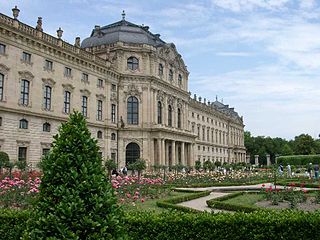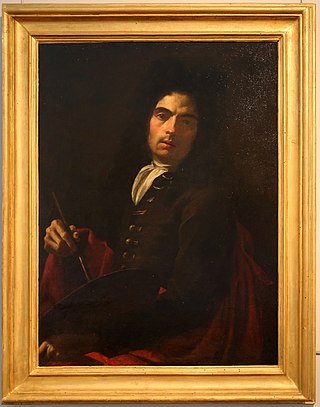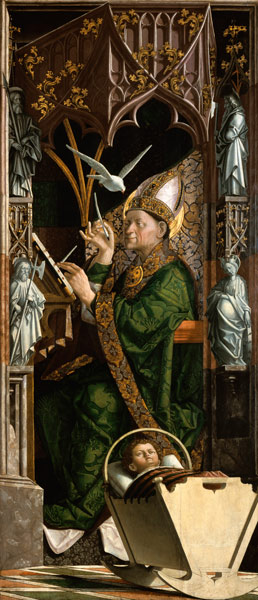
Belvedere Palace Chapel is a chapel located in the south eastern corner tower of the Upper Belvedere in Vienna, Austria. It was designed by the Austrian architect Johann Lukas von Hildebrandt. [1]

Belvedere Palace Chapel is a chapel located in the south eastern corner tower of the Upper Belvedere in Vienna, Austria. It was designed by the Austrian architect Johann Lukas von Hildebrandt. [1]
Construction of the chapel was completed in 1723. [1] The Palace Chapel was first opened to the public in May 1753. Up to this time, it had been reserved for the daily prayers of Prince Eugene and a select group of eminent individuals made up of the nobility, artists, and scholars. An Inventory of the Imperial and Royal Palace Chapel in the Belvedere from 1776 lists all the articles required to hold a Holy Mass. It can therefore be assumed with certainty that it was used for ecclesiastical purposes. At the end of the war in 1918 and the abdication of the last emperor of the Habsburg monarchy, the palace ensemble became state property. While both palaces were severely damaged during World War II, the Belvedere Palace Chapel survived intact.
The chapel initially remained unused, but was returned to its original use under the direction of Hans Aurenhammer. Commemorative Masses were celebrated each year on two occasions: on April 21, the anniversary of the death of Prince Eugene of Savoy, and on June 28, the anniversary of the death of Archduke Franz Ferdinand of Austria. Hans Aurenhammer's successor as director, Hubert Adolph, initiated regular Sunday Mass in the Palace Chapel that was open to the public. This Mass was conducted on an alternating basis by priests from St. Elisabeth's Church and St. Paul's Church. In addition, Adolph had a small organ fitted in the chapel.
As federal government property, the chapel is part of the Belvedere's museological collection. As part of an agreement with the federal government, it is now open every Sunday at midday for Catholic Holy Mass. [1] According to ecclesiastical law, the chapel is situated in the Viennese parish of St. Charles Borromeo. In recent decades, Mass in the Belvedere Palace Chapel has been celebrated by the military chaplain, Monsignor Professor Alfred Sammer.
The chapel is decorated in red-brownish and stucco marbling with contrasting white walls and gold gildings. The impression evokes the two marble halls in the Upper and Lower Belvedere. Hildebrandt used the best available artists for the decoration. [1]
The Resurrection of Jesus Christ altarpiece was painted by Neapolitan painter Francesco Solimena over a period of ten years and completed in 1729. [1] A model of Solimena's altarpiece by Santino Bussi is displayed in the hall next to the chapel. Bussi was also responsible for the jewelry in the remaining halls of the Upper Belvedere. [1] The sculptures of Saint John the Baptist and Saint Peter were executed by Domenico Parodi from Genoa. [1]
The ceiling fresco is by Carlo Innocenzo Carlone from northern Italy and depicts God the Father with the Holy Spirit as a dove surrounded by angels. It was completed in 1723. The fresco figures of God the Father and the Holy Spirit, along with Jesus Christ in the altarpiece, form a trinity. [1]

The Apostolic Palace is the official residence of the pope, the head of the Catholic Church, located in Vatican City. It is also known as the Papal Palace, the Palace of the Vatican and the Vatican Palace. The Vatican itself refers to the building as the Palace of Sixtus V, in honor of Pope Sixtus V, who built most of the present form of the palace.

Baroque architecture is a highly decorative and theatrical style which appeared in Italy in the early 17th century and gradually spread across Europe. It was originally introduced by the Catholic Church, particularly by the Jesuits, as a means to combat the Reformation and the Protestant church with a new architecture that inspired surprise and awe. It reached its peak in the High Baroque (1625–1675), when it was used in churches and palaces in Italy, Spain, Portugal, France, Bavaria and Austria. In the Late Baroque period (1675–1750), it reached as far as Russia and the Spanish and Portuguese colonies in Latin America. About 1730, an even more elaborately decorative variant called Rococo appeared and flourished in Central Europe.

The Belvedere is a historic building complex in Vienna, Austria, consisting of two Baroque palaces, the Orangery, and the Palace Stables. The buildings are set in a Baroque park landscape in the third district of the city, on the south-eastern edge of its centre. It houses the Belvedere museum. The grounds are set on a gentle gradient and include decorative tiered fountains and cascades, Baroque sculptures, and majestic wrought iron gates. The Baroque palace complex was built as a summer residence for Prince Eugene of Savoy.

The Church of the Gesù is the mother church of the Society of Jesus (Jesuits), a Catholic religious order. Officially named Chiesa del Santissimo Nome di Gesù all'Argentina, its facade is "the first truly baroque façade", introducing the baroque style into architecture. The church served as a model for innumerable Jesuit churches all over the world, especially in the Americas. Its paintings in the nave, crossing, and side chapels became models for Jesuit churches throughout Italy and Europe, as well as those of other orders. The Church of the Gesù is located in the Piazza del Gesù in Rome.

Johann Bernhard Fischer von Erlach was an Austrian architect, sculptor, engraver, and architectural historian whose Baroque architecture profoundly influenced and shaped the tastes of the Habsburg Empire. His influential book A Plan of Civil and Historical Architecture (1721) was one of the first and most popular comparative studies of world architecture. His major works include Schönbrunn Palace, Karlskirche, and the Austrian National Library in Vienna, and Schloss Klessheim, Holy Trinity Church, and the Kollegienkirche in Salzburg.

The Würzburg Residence is a palace in Würzburg, Germany. Johann Lukas von Hildebrandt and Maximilian von Welsch, representatives of the Austrian/South German Baroque style, were involved in the construction, as well as Robert de Cotte and Germain Boffrand, who were followers of the French Style. Balthasar Neumann, court architect of the Bishop of Würzburg, was the principal architect of the Residence, which was commissioned by the Prince-Bishop of Würzburg Johann Philipp Franz von Schönborn and his brother Friedrich Carl von Schönborn in 1720, and completed in 1744. The Venetian painter Giovanni Battista Tiepolo, assisted by his son, Domenico, painted frescoes in the building.

Corrado Giaquinto was an Italian Rococo painter.

Johann Lukas von Hildebrandt was an Austrian baroque architect and military engineer who designed stately buildings and churches and whose work had a profound influence on the architecture of the Habsburg Empire in the eighteenth century. After studying in Rome under Carlo Fontana, he constructed fortresses for Prince Eugene of Savoy during his Italian campaigns, becoming his favorite architect. In 1700 he became court engineer in Vienna, and in 1711 was named head of the court department of building. He became court architect in 1723. His designs for palaces, estates, gardens, churches, chapels, and villas were widely imitated, and his architectural principles spread throughout central and southeast Europe. Among his more important works are Palais Schwarzenberg, St. Peter's Church, and Belvedere in Vienna, Savoy Castle in Ráckeve, Schönborn Palace in Göllersdorf, and Schloss Hof.

Michael Pacher was a painter and sculptor from Tyrol active during the second half of the fifteenth century. He was one of the earliest artists to introduce the principles of Renaissance painting into Germany. Pacher was a comprehensive artist with a broad range of sculpting, painting, and architecture skills producing works of complex wood and stone. He painted structures for altarpieces on a scale unparalleled in North European art.

The Scala Sancta are a set of 28 white marble steps located in an edifice on extraterritorial property of the Holy See in Rome, Italy proximate to the Archbasilica of Saint John in Laterano. Officially, the edifice is titled the Pontifical Sanctuary of the Holy Stairs, and incorporates part of the old Papal Lateran Palace. Replica stairs flank the original staircase, which may only be climbed on one's knees. The Holy Stairs lead to the Church of Saint Lawrence in Palatio ad Sancta Sanctorum or simply the "Sancta Sanctorum", which was the personal chapel of the early Popes.

Pfitsch is a comune (municipality) South Tyrol in northern Italy, located about 45 kilometres (28 mi) north of the city of Bolzano, on the border with Austria. It is named for the valley of Pfitschtal or Pfitscher Tal.

Gesù Nuovo is the name of a church and a square in Naples, Italy. They are located just outside the western boundary of the historic center of the city. To the southeast of the spire, one can see a block away the Fountain of Monteoliveto and the piazza of the church of Sant'Anna dei Lombardi. The square is a result of the expansion of the city to the west beginning in the early 16th century under the rule of Spanish viceroy Pedro Alvarez de Toledo. The square of Gesù Nuovo contains three prominent landmarks:

Schloss Weißenstein is a Schloss or palatial residence in Pommersfelden, Bavaria, southern Germany. It was designed for Lothar Franz von Schönborn, Prince-Bishop of Bamberg and Archbishop of Mainz, to designs by Johann Dientzenhofer and Johann Lukas von Hildebrandt. Weißenstein, built as a private summer residence, remains in the Schönborn family. It is considered a masterwork of Baroque architecture.

The Basilica della Santissima Annunziata del Vastato is the Catholic cathedral of Genoa, northern Italy; its decoration employed the major baroque studios and artists in Genoa in the 17th century.
Events from the year 1690 in art.

Santa Maria dei Carmini, also called Santa Maria del Carmelo and commonly known simply as the Carmini, is a large Roman Catholic church in the sestiere, or neighbourhood, of Dorsoduro in Venice, northern Italy. It nestles against the former Scuola Grande di Santa Maria del Carmelo, also known as the Scuola dei Carmini. This charitable confraternity was officially founded in 1597, and arose from a lay women's charitable association, the Pinzocchere dei Carmini. The members of this lay group were associated as tertiaries to the neighbouring Carmelite monastery. They were responsible for stitching the scapulars for the Carmelites.

Johann Jakob Zeiller was an Austrian painter.

The Chiesa della Santissima Trinità dei Pellegrini is a Roman Catholic church located on Via dei Pettinari #36 In the rione of Regola of central Rome, Italy. It stands a block away from the Palazzo Spada on Via Capo di Ferro, while a few blocks away on the Via dei Pettinari stands the Ponte Sisto.

Gesù e Maria is a Baroque church located on Via del Corso in the Rione Campo Marzio of central Rome, Italy. It faces across the street the similarly Baroque facade of San Giacomo in Augusta.

The Winter Palace of Prince Eugene, also known as the City Palace, is a high-Baroque palace in the Innere Stadt district of Vienna, Austria. Located on a narrow street at Himmelpfortgasse 8, the palace was used as the winter residence of Prince Eugene of Savoy, who spent his summers at the Belvedere. The Winter Palace was designed and constructed by Johann Bernhard Fischer von Erlach from 1695 to 1700, and by Johann Lukas von Hildebrandt from 1702 to 1724 following his predecessor's plans.
Coordinates: 48°11′29″N16°22′51″E / 48.191439°N 16.380787°E